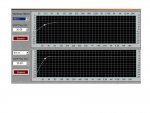Or maybe not 
I bought 4 used Labsubs from Silas Pradetto a while back; they arrived here two days ago. They were slightly delayed in a hurricane, but made it through unharmed and well. Initial test suggest that their performance is pretty impressive compared to 4xsb1000 or 4x650-r2 which I've previously used with my SH-50s. They outrun two SH-50s pretty easily, and my whole warehouse is shaking in its foundation, I like that.
The picture is from our industry standard test procedure FTLC6P, and I ended up with a 12dB Butterworth hi-pass@25hz, an LR24dB LP@80hz on the Labs, and a 24dB LR@100hz on the SH-50s with 5ms of delay. I currently set my limiter at 57V(800W/4ohm) and they seem to cope with that amount of power just fine. If anybody has some settings they wish to recommend for the Labs, I'm open for suggestions.
I do believe that this is the first operational Labs in Norway, and they are available for rent if you're around in these parts of the world
Many thanks to Silas for the deal
I bought 4 used Labsubs from Silas Pradetto a while back; they arrived here two days ago. They were slightly delayed in a hurricane, but made it through unharmed and well. Initial test suggest that their performance is pretty impressive compared to 4xsb1000 or 4x650-r2 which I've previously used with my SH-50s. They outrun two SH-50s pretty easily, and my whole warehouse is shaking in its foundation, I like that.
The picture is from our industry standard test procedure FTLC6P, and I ended up with a 12dB Butterworth hi-pass@25hz, an LR24dB LP@80hz on the Labs, and a 24dB LR@100hz on the SH-50s with 5ms of delay. I currently set my limiter at 57V(800W/4ohm) and they seem to cope with that amount of power just fine. If anybody has some settings they wish to recommend for the Labs, I'm open for suggestions.
I do believe that this is the first operational Labs in Norway, and they are available for rent if you're around in these parts of the world
Many thanks to Silas for the deal


